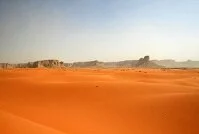Weather

Red sands in the desert
Saudi Arabia is a fairly large country, but weather extremes from area to area are fairly mild. Almost the entire country is desert, with the exception of the southwest. The greatest variations in the weather patterns come with seasons and regions, as the coastal regions tend to have different tendencies then there are inland. Summers tend to get quite hot throughout the country with internal desert temperatures regularly reaching 120° F (50° C) during the day, but nights falling significantly to the 70s° F (21-26° C). Along the coasts the air is more humid and temperatures rarely get above 100° F (38° C). Winters are only slightly cooler during the day in the desert, while highs along the coast tend to hit about 80° F (27° C). During these months though there is little humidity and with strong winds, evenings can feel cold with average lows of nearly 60° F (16° C) during the winter along the coasts. In the southwest rain is more common and temperatures more temperate throughout the year.
Wildlife

Arabian horse
The animal life in Saudi Arabia is very limited due to the desert climate and most of the animals live either off the coast in the seas or in the southwest where there is more greenery. The most notable mammal in the country is the camel, although smaller mammals also exist, like the ibex, goat, hyena, and smaller mammals and rodents. The sea life is primarily limited to the Persian Gulf and Red Sea as these two seas contain incredible sea life and the Red Sea also boasts a number of great corals, which only add to the animal diversity.
Among the birds in Saudi Arabia, most only pass by on their migratory route, but the number of birds on this migratory route is incredibly large. Among the most common birds are flamingos, pelicans, pigeons, and buzzards. There are few amphibians in the country, but a number of reptiles, including lizards and snakes.